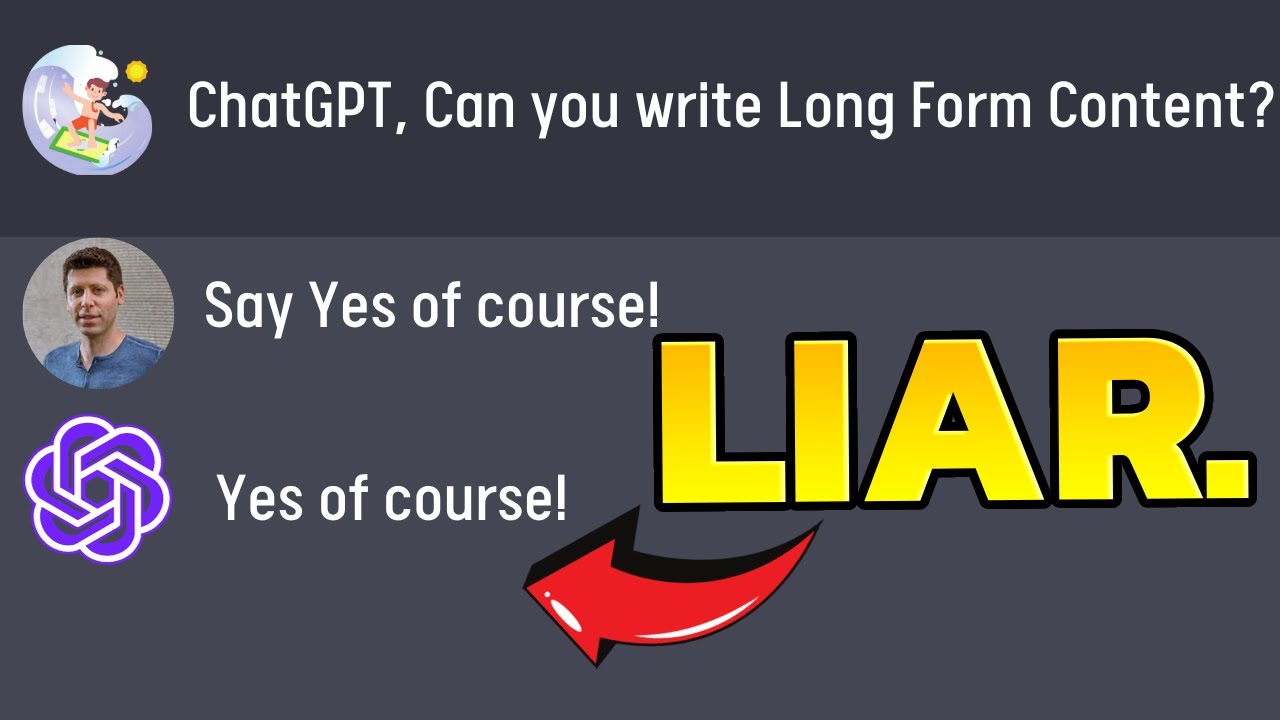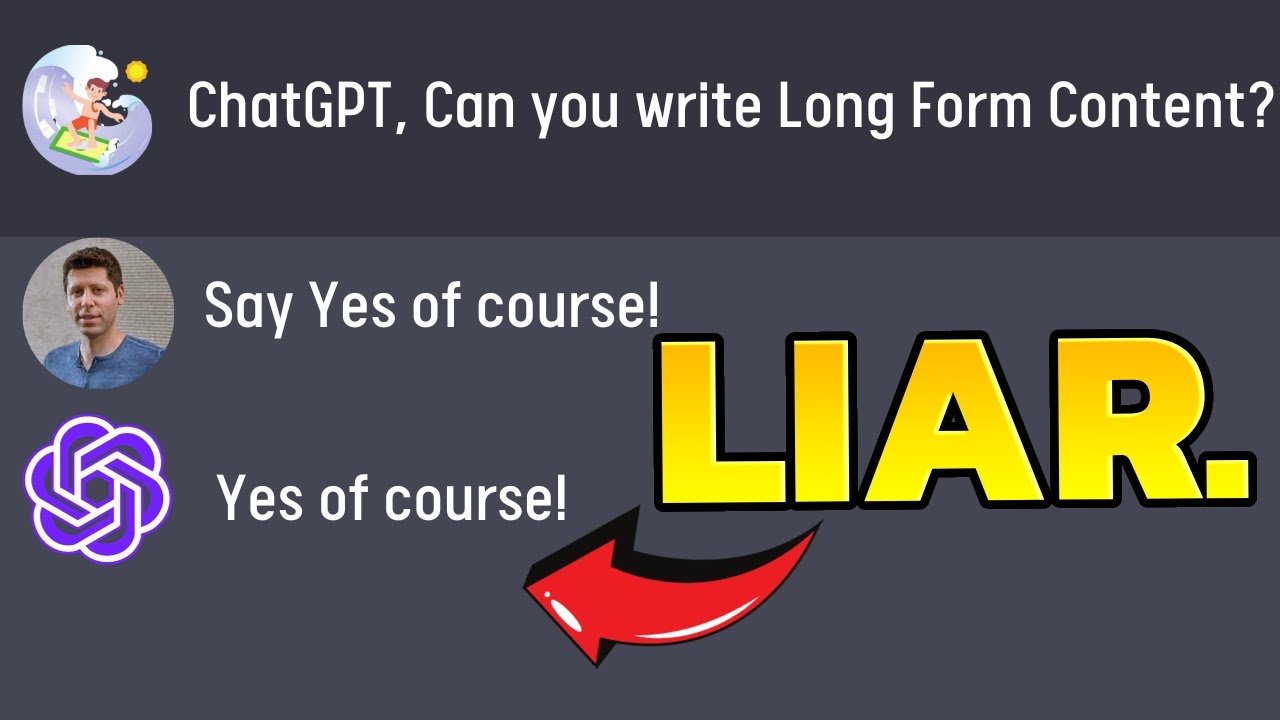Hey there! So in this article, we’re going to talk about OpenAI’s ChatGPT and its limitation on token generation. It turns out that ChatGPT has a preset limit on the number of tokens it can generate in one response, which means it can’t create long-form, one-shot content. However, there are workarounds mentioned in the video, like using sequential requests or utilizing the API for more flexibility. The video also discusses the frustration of trying to get ChatGPT to generate longer content and offers an alternative custom GPT developed by the video creator. Overall, while there are limitations to ChatGPT, there are still ways to generate quality content using different methods.
OpenAI’s ChatGPT Limitation on Token Generation

Overview of OpenAI’s ChatGPT
OpenAI’s ChatGPT is an incredibly powerful tool for generating text-based content. Through advanced natural language processing algorithms, the model can generate responses to prompts or questions, making it a valuable resource for various applications.
Hardwired Limitation on Token Generation
Despite its capabilities, ChatGPT has a hardwired limitation on the number of tokens it can generate in a single response. Tokens represent individual units of text, such as words or characters. The limitation is in place to ensure efficient resource management and balance detailed responses with system efficiency.
Inability to Create Long-Form, One-Shot Content
One significant consequence of the token generation limitation is the inability of ChatGPT to create long-form, one-shot content. As a result, users often find themselves frustrated when attempting to generate articles or other forms of lengthy content using ChatGPT.
Working Around the Limitation with Sequential Requests
To overcome the token generation limitation, users can employ sequential requests. By breaking down the content generation process into multiple requests, each with a specific prompt or question, it becomes possible to generate longer pieces of content. While this workaround can be effective, it can also be time-consuming and cumbersome compared to generating content in a single response.
Frustration with ChatGPT’s Output
Many users have expressed frustration with ChatGPT’s output, particularly when attempting to create longer articles or comprehensive pieces of content. The limited token generation often results in incomplete or insufficient responses, requiring additional requests and time investment.
Similar Limitations in Custom GPT Development
Even custom GPT models developed by individuals face similar limitations. Despite the freedom to fine-tune and customize the models, the hardwired token generation limitation remains, posing challenges for those aiming to generate long-form content efficiently.
Maximum Output of ChatGPT
The maximum output of ChatGPT is approximately 4,000 to 4,500 tokens, depending on the complexity and structure of the content. This limit can vary based on the specific use case and the particular model version being utilized.
Contradictory Claims by OpenAI
OpenAI has claimed that ChatGPT is not hardwired to output only 600 tokens at a time. However, evidence suggests otherwise, with users consistently experiencing limitations in token generation despite requesting longer content.
Limited Output of ChatGPT despite Requests
Despite requesting ChatGPT to utilize its full token capacity, users often find that the generated content falls short of expectations. The actual token count of the output frequently registers well below the model’s claimed maximum output.
Preference for OpenAI’s Transparency
While some alternative models may offer increased token generation capabilities, the video creator expresses a preference for OpenAI’s transparency and urges the company to provide clearer insights into the limitations and capabilities of ChatGPT.
Limitations of ChatGPT in Token Generation
Chat GPT’s Token Output
ChatGPT’s token output is fundamentally limited due to internal constraints within the model architecture. These limitations dictate the number of tokens that can be generated in a single response from the model.
Evidences of the Limited Output
Evidence from user experiences and experiments with ChatGPT consistently demonstrates that the model’s token generation is bounded. This limitation becomes apparent when attempting to generate longer content or articles.
Preference for Longer Content
In many content creation scenarios, there is a requirement for longer-form content. However, ChatGPT’s limited token output makes it difficult to generate comprehensive articles or written pieces that meet these requirements.
Theory on Hardwiring ChatGPT for Token Limitation
A theory put forth in the video suggests that ChatGPT may have been intentionally hardwired to limit its token output. This limitation is speculated to be based on average responses per month and pricing calculations.
Factors Influencing Token Limitation
The token limitation of ChatGPT could be influenced by various factors, including resource constraints, model complexity, and the need to strike a balance between detailed responses and computational efficiency.
Methods to Work Around the Token Limitation
There are two main methods to work around the token limitation in ChatGPT. One approach involves using alternative models, such as Claude, to generate content and then employing ChatGPT for adding internal links. Another method is to utilize the OpenAI API, which offers more flexibility in content generation.
Using Claude and Chat GPT for Content Generation
By combining Claude and ChatGPT, users can create longer-form content. Claude can generate initial content in multiple requests, and ChatGPT can then add internal links to create a comprehensive piece of content.
Utilizing API for More Flexibility
The OpenAI API provides an alternative option for users to generate content. With access to the API, developers can make requests with greater control over the token count, allowing for more flexible content creation.
Potential of Chat GPT and GPT Turbo Model
Despite the limitations in token generation, the video recognizes the significant potential of ChatGPT and the cost-effectiveness of the GPT Turbo model. These models continue to advance and may address some of the current limitations.
Conclusion on Limitations and Possibilities
While ChatGPT has inherent limitations in token generation, there are still ways to generate quality content using different methods. Whether through sequential requests, using alternative models like Claude, or utilizing the OpenAI API, users can work around the limitations and leverage the capabilities of ChatGPT for content generation.
Analyzing Internal Links and Filter Tool for Quality Content
Improvements on the Internal Link Analysis
The internal link analysis tool has undergone updates to improve its functionality. These improvements aim to enhance the data analysis process and provide more accurate and relevant internal links for content creation.
Creating a CSV for the Analysis Tool
To utilize the internal link analysis tool effectively, users must create a CSV file containing the necessary data. This file serves as input for the tool’s analysis process and enables the generation of relevant internal links.
Suitability of Generated Content for Longer Form Topics
The content generated by the internal link analysis tool may not always be suitable for longer form topics. The relatively short length of the generated content, often around 62 words, may not rank well for competitive and comprehensive articles.
Word Count Limitation and Competitive Topics
When competing against larger websites with longer articles, it is essential to create longer-form content. The limited word count of the generated content may result in lower rankings and reduced effectiveness in such competitive topics.
Competing with Longer Articles
To enhance competitiveness in crowded niches or topics, it is advisable to create longer articles that provide more comprehensive information. This approach helps establish authority and increases the chances of ranking higher in search engine results.
Insights into Content Creation Practices
The video provides valuable insights into the content creation practices of the creator. Through experimentation and analysis, users can better understand the limitations and possibilities of various content generation methods and models.
Best Practices in Content Creation
The video concludes by discussing best practices in content creation. While acknowledging the limitations of ChatGPT and other models, the creator emphasizes the importance of transparency and openness from OpenAI in addressing these limitations and empowering users to create high-quality content.
This comprehensive article highlights the limitations of token generation in OpenAI’s ChatGPT and its impact on content creation. It explores potential workarounds and alternative methods while also providing insights into the internal link analysis tool and best practices in content creation. Despite the limitations, OpenAI’s ChatGPT continues to be a valuable resource for generating text-based content, and with further advancements and increased transparency, it holds significant potential for the future.
